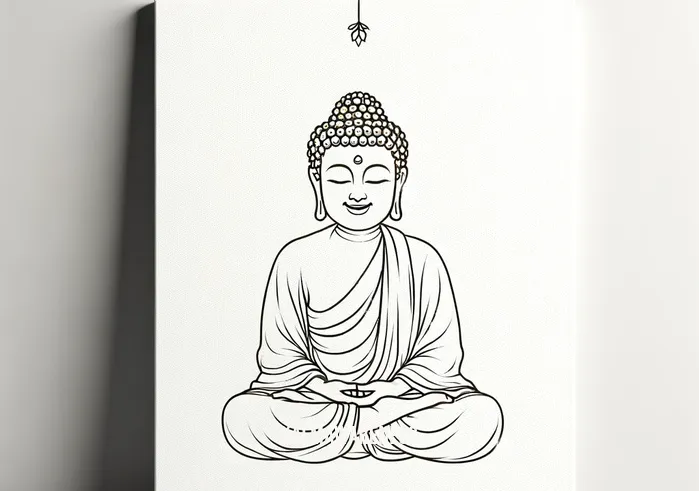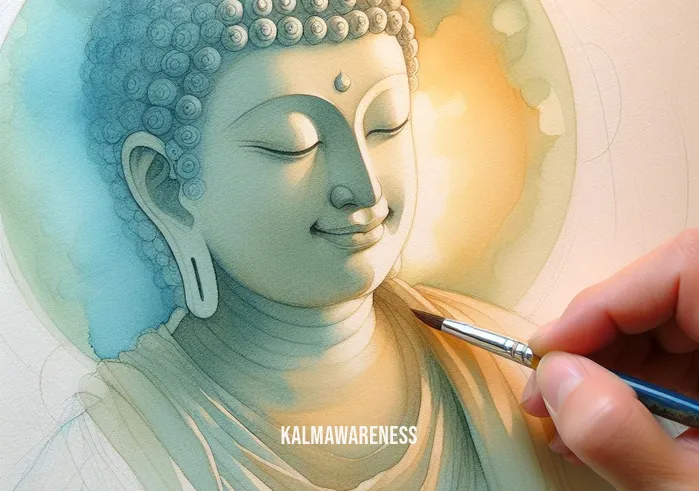The Art of Zen and Serenity: Discovering Simple Buddha Drawing and the Pursuit of Happiness
Art transcends the boundaries of language and culture, acting as a universal medium that brings humans closer to understanding themselves and the world around them. Among the myriad of symbols and depictions, the image of Buddha stands out, particularly the simple Buddha drawing happy. This symbol encompasses more than just the essence of serenity and harmony; it embodies an entire philosophy of life. Throughout this journey, we’ll unravel the profound meaning behind this seemingly straightforward sketch and its relevance in our modern, chaotic world.
The Historical Significance of Buddha in Art
From ancient sculptures to minimalist drawings, Buddha’s representation has witnessed an evolution in art. However, the essence remains unchanged: it’s a symbol of peace, enlightenment, and a quest for the true self. An uncomplicated drawing of a happy Buddha not only reflects the core principles of Buddhism but also serves as an inspiration for those in search of inner tranquility. For many, the Buddha’s image acts as a reminder to relax and be aware, acknowledging the present moment and finding contentment within it.
Zen Art and the Essence of Minimalism
Zen Buddhism emphasizes simplicity, and this philosophy spills over into art. The beauty of a simple Buddha drawing happy is in its minimalistic approach. With just a few strokes, it captures an ocean of emotions and wisdom. Such minimalism in art urges us to realize that happiness is not about having more, but about appreciating what we have. This understanding aligns with the lessons from comfort meditation, where finding solace in simplicity is the key.
Harmony in Symbols
Symbols carry an inherent power, influencing our perceptions and emotions. When we look at the 8th chakra symbol, we are reminded of spiritual connection and universal energy. Similarly, a simple depiction of a joyful Buddha bridges the gap between the physical and spiritual, urging us to find balance. This balance can also be felt when surrounded by calming ocean pictures, where the vastness of the sea mirrors the boundless potential within us.
Art as a Tool for Inner Exploration
Drawing or even gazing upon art can be a meditative experience. When an artist embarks on creating a simple Buddha drawing happy, they are not just sketching an image but also tuning into a higher frequency. This frequency, much like the 111 frequency, can elevate our vibrations, leading us closer to enlightenment. For some, this experience might be akin to floating meditation, where one feels detached from worldly constraints, basking in pure consciousness.
Looking Forward: The Journey Continues
While we’ve briefly touched upon the essence and significance of a happy Buddha drawing in the realms of art, Zen, and symbolism, the exploration is far from over. In our upcoming segments, we’ll delve deeper into the nexus between art and spirituality, drawing parallels with phenomena like seeing faces during meditation or understanding the spiritual undertones of seemingly mundane experiences. The quest for happiness and serenity is a continuous one, and art, especially symbols like the Buddha, acts as a compass guiding us through this journey.
Stay with us as we embark on this enlightening adventure. The depth of our exploration knows no bounds, and we promise that every chapter will be a step closer to self-discovery and inner peace. Continue reading, for the journey has only just begun.

The Multifaceted Interpretations of a Simple Buddha Drawing: Exploring Happiness and Symbolism
Art is an evolving language, and the simple act of drawing can communicate profound insights and emotions. Delving deeper into our topic, the simple Buddha drawing happy, we can observe how art communicates a rich tapestry of ideas that vary based on the viewer’s perspective.
Interpreting the Lines: Emotions Captured in a Sketch
When one examines a Buddha drawing, they don’t just see lines and curves but emotions and philosophies. The smile, eyes, and posture of the Buddha convey a range of sentiments:
- Joy: An overt expression showcasing the Buddha’s inner happiness.
- Serenity: Represented by calm eyes and a relaxed demeanor, echoing the tranquility of calming rain.
- Wisdom: Often depicted through the Buddha’s posture, reminiscent of elders who’ve achieved enlightenment.
- Compassion: The gentle gaze, reflecting the essence of blessing love.
The Power of Colors in Art
Though a simple Buddha drawing happy can be a black and white sketch, adding color can elevate its significance. Colors, like symbols, have a story to tell. They can intensify emotions or add layers to the narrative.
- Gold symbolizes purity in Buddhist traditions, capturing the essence of the angel Anael.
- Blue, often associated with peace, mirrors the calming energy of calming ocean pictures.
- White signifies purity, aligning with the principles of clearing energy meditation.
Table of Emotions and Corresponding Symbols
| Emotion | Symbol in Buddha Drawing | Associated Practice |
|---|---|---|
| Joy | Radiant smile | Floating Meditation |
| Serenity | Calm eyes | Desert Meditation |
| Wisdom | Lotus-seated posture | Closing Spiritual Portals |
| Compassion | Gentle gaze | Guided Meditation for Peaceful Sleep |
| Purity | White robe | Peace in the Family |
The Modern Relevance of a Timeless Symbol
While the Buddha’s teachings date back centuries, their essence remains timeless. The simple Buddha drawing happy isn’t just a symbol of an ancient philosophy but a beacon for modern souls navigating the complexities of today’s world. It reminds us to look inward, echoing the practices of object lover, and understand our true desires and passions.
Setting the Stage for a Deeper Dive
While this chapter shed light on the multiple interpretations of a simple drawing, our journey has merely scratched the surface. The profound significance of the simple Buddha drawing happy is vast, with many dimensions yet to be explored.
Ready for a deeper dive? Continue reading. The next chapter promises an even more enriching exploration, uncovering layers of understanding that can transform our perspective on art, symbolism, and life itself.

The Light Within: Unraveling Hope and Inspiration Through the Simple Buddha Drawing
The world of art is a mirror reflecting the myriad of emotions, aspirations, and philosophies we humans hold within. In the center of this vast expanse stands the humble simple Buddha drawing happy, a beacon of hope and inspiration for countless souls. The minimalist lines of this drawing resonate deeply, teaching us the significance of finding joy and serenity amidst chaos. As we venture deeper into the inspiration behind this drawing, we encounter stories, quotes, and real-life examples that illuminate its transformative power.
Whispers of Hope in Every Curve
Buddha’s depiction in various art forms has always symbolized a journey from ignorance to enlightenment. The simplicity of a joy-filled Buddha drawing offers profound insights, much like the wisdom behind angel Muriel’s guidance. Within this illustration lies a message – happiness is accessible, and enlightenment is attainable.
“Happiness is not something ready-made. It comes from your own actions.” – Dalai Lama
This sentiment aligns seamlessly with the essence of the drawing, emphasizing that joy is a byproduct of our choices, actions, and perspectives.
Stories of Resilience and Inspiration
An artist named Maya, grappling with life’s adversities, found solace in sketching. One evening, as the weight of her challenges threatened to engulf her, she found herself sketching a Buddha. Unlike her detailed masterpieces, this was a simple Buddha drawing happy. To her surprise, the act was therapeutic. As she traced the Buddha’s serene face, she felt an outpour of emotions – hope, serenity, and a newfound inspiration. This drawing, inspired by the practices of best frequencies for anxiety, became a symbol of her resilience and a constant reminder that happiness is a journey, not a destination.
“In the midst of chaos, there is also opportunity.” – Sun Tzu
Maya’s story is not isolated. Numerous artists and admirers of art have found solace in the Buddha’s serene depiction, deriving strength from his tranquil demeanor.
The Inspirational Prowess of a Simple Sketch
One might wonder, how can a basic drawing hold such power? The answer lies in its universality. A simple Buddha drawing happy is devoid of complexities, making it relatable and accessible.
“The simpler you say it, the more eloquent it is.” – August Wilson
Connecting with the principles of spiritual meaning of lower back pain, this artwork speaks of bearing burdens gracefully, encouraging us to face adversities with a smile.
Stepping into a Realm of Deeper Understanding
While the drawing’s simplicity is its strength, it’s essential to understand that this simplicity is not about a lack of depth. Instead, it signifies purity, echoing the sentiments of what the number 800 means spiritually. The simplicity serves as an invitation to dig deeper, to understand the profound philosophy it stands for, and to embrace the serenity it promises.
“Simplicity is the ultimate sophistication.” – Leonardo da Vinci
Journeying Forward: The Path of Enlightenment Awaits
As we’ve journeyed through the realms of hope, inspiration, and resilience, the simple Buddha drawing happy stands as a testament to the power of art in transforming lives. But, like any profound philosophy, there are always more layers to uncover and understand.
Eager to dive deeper into the realms of serenity, creativity, and art? Continue reading. Our next chapter promises to take you on an even more enlightening journey, shedding light on the intricacies of symbolism, art, and the quest for inner peace.
@
Dissecting the Essence: Unpacking the Symbolism of a Simple Buddha Drawing
As we’ve navigated the realms of hope, inspiration, and enlightenment, the recurring motif remains the simple Buddha drawing happy. This chapter delves deeper into its essence, breaking down the symbolism and understanding layered within its simple strokes. By leveraging bullet points and lists, we’ll attempt to make this exploration both informative and digestible.
Components of the Simple Buddha Drawing
To understand the power behind this drawing, we must first recognize its core elements:
- Facial Expression: The Buddha’s calm demeanor and gentle smile embody peace, a notion aligned with the tranquility of floating meditation.
- Posture: Typically seated in a meditative stance, the Buddha’s posture suggests stability and grounding.
- Auspicious Marks: Although a simplistic depiction, keen observers might notice certain marks, symbolizing different spiritual lessons.
Significance Behind the Drawing’s Elements
Each element of the Buddha drawing carries a profound message, deeply rooted in Buddhist teachings and wider spiritual philosophies.
The Gentle Smile:
- Symbolizes contentment and inner peace.
- Reflects the joys of blessing love and compassion towards all beings.
- Serves as a reminder of the happiness attainable in the present moment.
Meditative Posture:
- Embodies a state of deep introspection and connection to the universe.
- Echoes the grounding essence of calming ocean pictures where tranquility meets vastness.
- Acts as an invitation for viewers to embark on their meditation journey, much like the serenity one finds in desert meditation.
Auspicious Marks:
- These marks, often subtle in simple drawings, carry lessons on virtues like patience, diligence, and wisdom.
- They serve as a roadmap, guiding spiritual seekers on their path.
Evolution of the Drawing Over Time
Art is ever-evolving, and the Buddha’s depiction is no exception:
- Early Depictions: Initial representations focused on symbolic representations rather than human form, resonating with the mystery behind seeing faces during meditation.
- Golden Age of Buddhist Art: This era witnessed a surge in detailed, ornate Buddha depictions, celebrating spiritual opulence.
- Modern Interpretations: Today’s simple Buddha drawing happy is a blend of minimalism and profound spirituality, aiming to make Buddhist teachings more accessible to the modern seeker.
The Drawing in Contemporary Culture
The resonance of the simple Buddha drawing in today’s world:
- Its universality makes it a popular motif in home décor, instilling spaces with tranquility reminiscent of calming rain.
- As a tattoo, it serves as a permanent reminder of one’s spiritual journey and commitment to inner peace.
- In digital media, the drawing bridges ancient wisdom with modern aesthetics, making it a favorite among designers and spiritual practitioners alike.
Onward to Conclusion: Piecing Together the Puzzle
While the strokes may seem simple, the simple Buddha drawing happy is a rich tapestry of teachings, symbolism, and spiritual resonance. Each line, curve, and mark carries with it a world of understanding. As we’ve unraveled its layers, the picture becomes clear: this drawing is not just an artwork; it’s a spiritual guide.
Eager to see how all these pieces fit together? In our concluding chapter, we’ll synthesize our understanding, capturing the heart of this beautiful, serene symbol. Stay with us for the final exploration.
@
Reflections on Serenity: The Enduring Charm of a Simple Buddha Drawing
As our exploration on the simple Buddha drawing happy winds to its end, it’s time to step back and appreciate the serenity and depth packed within those seemingly humble lines. The calm, unassuming image of Buddha, with a gentle smile, offers profound wisdom, insights, and most importantly, a beacon of hope in our chaotic world. This chapter intends to tie our journey together, reflecting on the main takeaways and the way forward.
A Journey of Discovery
From the early chapters, where we first introduced this iconic drawing, to the in-depth breakdown and the inspirations it evokes, our path has been both enlightening and transformative. It’s akin to the refreshing ambiance of clearing energy meditation, cleansing the soul and offering clarity.
Wisdom in Simplicity
The simple Buddha drawing happy is much more than art. It symbolizes:
- A life of moderation, echoing sentiments similar to relax and be aware.
- The quest for enlightenment and the transformative power of mindfulness.
- The embrace of serenity amidst life’s tumultuous waves, akin to the calming effects of best frequency for anxiety.
Incorporating the Lessons
So, how can one weave these teachings into their daily fabric?
- Mindfulness: Much like the teachings embedded within the guided meditation for peaceful sleep, mindfulness can be practiced every day.
- Appreciation: Celebrate the little joys, just as Buddha’s drawing revels in simple happiness.
- Seeking Knowledge: Stay curious, delve deeper into spiritual realms, and explore the mysteries of spiritual meaning of lower back pain or the symbolism of the 8th chakra.
A Heartfelt Thank You
To our cherished readers, your engagement fuels our dedication. As we ventured together through the depths of symbolism and serenity, your companionship made this journey invaluable. The power of simple Buddha drawing happy is mirrored in the strength of our shared quest for understanding.
The Path Forward
Our odyssey might be drawing to a close, but the spiritual voyage is endless. Dive deeper into our archives, revisit chapters for more insights, or explore other paradigms. Perhaps a delve into the comforting realms of comfort meditation will be your next stop?
As we part ways for now, remember the peace and wisdom symbolized in the Buddha’s tranquil face. Carry it with you, and may it light up your path. Until our next journey, stay curious, stay inspired.



